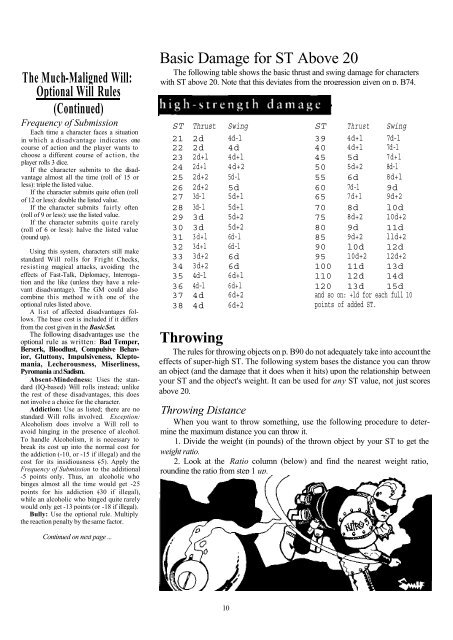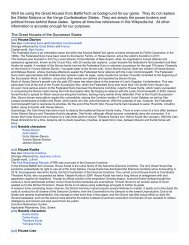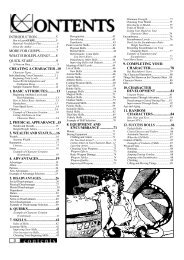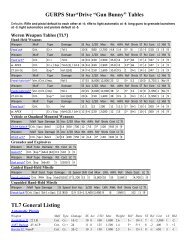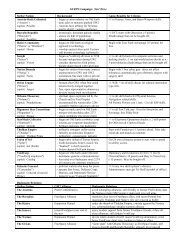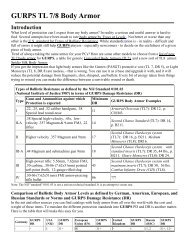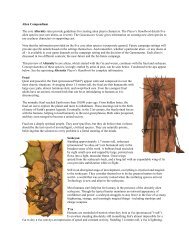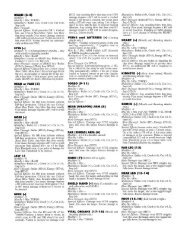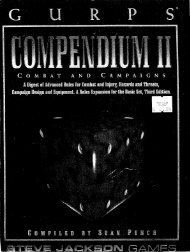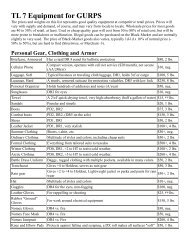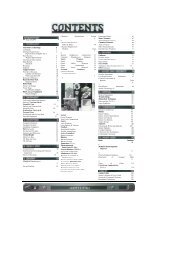GURPS - Compendium 1..
GURPS - Compendium 1..
GURPS - Compendium 1..
Create successful ePaper yourself
Turn your PDF publications into a flip-book with our unique Google optimized e-Paper software.
The Much-Maligned Will:<br />
Optional Will Rules<br />
(Continued)<br />
Frequency of Submission<br />
Each time a character faces a situation<br />
in which a disadvantage indicates one<br />
course of action and the player wants to<br />
choose a different course of action, the<br />
player rolls 3 dice.<br />
If the character submits to the disadvantage<br />
almost all the time (roll of 15 or<br />
less): triple the listed value.<br />
If the character submits quite often (roll<br />
of 12 or less): double the listed value.<br />
If the character submits fairly often<br />
(roll of 9 or less): use the listed value.<br />
If the character submits quite rarely<br />
(roll of 6 or less): halve the listed value<br />
(round up).<br />
Using this system, characters still make<br />
standard Will rolls for Fright Checks,<br />
resisting magical attacks, avoiding the<br />
effects of Fast-Talk, Diplomacy, Interrogation<br />
and the like (unless they have a relevant<br />
disadvantage). The GM could also<br />
combine this method with one of the<br />
optional rules listed above.<br />
A list of affected disadvantages follows.<br />
The base cost is included if it differs<br />
from the cost given in the Basic Set.<br />
The following disadvantages use the<br />
optional rule as written: Bad Temper,<br />
Berserk, Bloodlust, Compulsive Behavior,<br />
Gluttony, Impulsiveness, Kleptomania,<br />
Lecherousness, Miserliness,<br />
Pyromania and Sadism.<br />
Absent-Mindedness: Uses the standard<br />
(IQ-based) Will rolls instead; unlike<br />
the rest of these disadvantages, this does<br />
not involve a choice for the character.<br />
Addiction: Use as listed; there are no<br />
standard Will rolls involved. Exception:<br />
Alcoholism does involve a Will roll to<br />
avoid hinging in the presence of alcohol.<br />
To handle Alcoholism, it is necessary to<br />
break its cost up into the normal cost for<br />
the addiction (-10, or -15 if illegal) and the<br />
cost for its insidiousness (-5). Apply the<br />
Frequency of Submission to the additional<br />
-5 points only. Thus, an alcoholic who<br />
binges almost all the time would get -25<br />
points for his addiction (-30 if illegal),<br />
while an alcoholic who binged quite rarely<br />
would only get -13 points (or -18 if illegal).<br />
Bully: Use the optional rule. Multiply<br />
the reaction penalty by the same factor.<br />
Basic Damage for ST Above 20<br />
The following table shows the basic thrust and swing damage for characters<br />
with ST above 20. Note that this deviates from the progression given on p. B74.<br />
ST Thrust Swing ST Thrust Swing<br />
21 2d 4d-l 39 4d+l 7d-l<br />
22 2d 4d 40 4d+l 7d-l<br />
23 2d+l 4d+l 45 5d 7d+l<br />
24 2d+l 4d+2 50 5d+2 8d-l<br />
25 2d+2 5d-l 55 6d 8d+l<br />
26 2d+2 5d 60 7d-l<br />
27 3d-l 5d+l 65 7d+l<br />
9d<br />
9d+2<br />
28 3d-l 5d+l 70 8d l0d<br />
29 3d 5d+2 75 8d+2 10d+2<br />
30 3d 5d+2 80 9d 11d<br />
31 3d+l 6d-l 85 9d+2 lld+2<br />
32 3d+l 6d-l 90 l0d 12d<br />
33 3d+2 6d 95 10d+2 12d+2<br />
34 3d+2 6d 100 11d 13d<br />
35 4d-l 6d+l 110 12d 14d<br />
36 4d-l 6d+l 120 13d 15d<br />
37 4d 6d+2<br />
38 4d 6d+2<br />
and so on: +ld for each full 10<br />
points of added ST.<br />
Throwing<br />
The rules for throwing objects on p. B90 do not adequately take into account the<br />
effects of super-high ST. The following system bases the distance you can throw<br />
an object (and the damage that it does when it hits) upon the relationship between<br />
your ST and the object's weight. It can be used for any ST value, not just scores<br />
above 20.<br />
Throwing Distance<br />
When you want to throw something, use the following procedure to determine<br />
the maximum distance you can throw it.<br />
<strong>1.</strong> Divide the weight (in pounds) of the thrown object by your ST to get the<br />
weight ratio.<br />
2. Look at the Ratio column (below) and find the nearest weight ratio,<br />
rounding the ratio from step 1 up.<br />
Continued on next page ...<br />
10


